The Toshiba RC100 SSD Review: Tiny Drive In A Big Market
by Billy Tallis on June 14, 2018 9:00 AM ESTSequential Read Performance
Our first test of sequential read performance uses short bursts of 128MB, issued as 128kB operations with no queuing. The test averages performance across eight bursts for a total of 1GB of data transferred from a drive containing 16GB of data. Between each burst the drive is given enough idle time to keep the overall duty cycle at 20%.
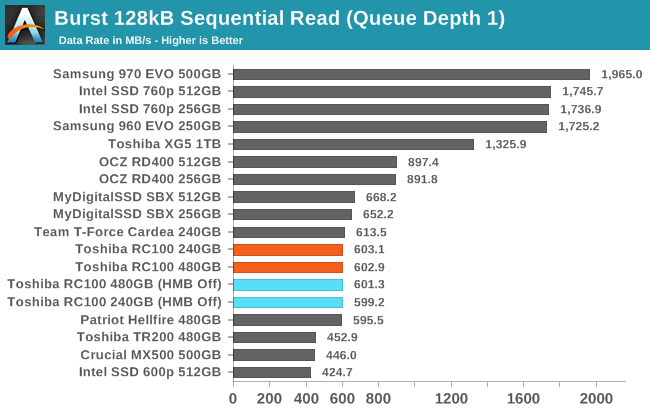
The burst sequential read performance of the Toshiba RC100 is faster than any SATA drive can manage, and is only slightly slower than the MyDigitalSSD SBX. The Host Memory Buffer feature has no significant impact here.
Our test of sustained sequential reads uses queue depths from 1 to 32, with the performance and power scores computed as the average of QD1, QD2 and QD4. Each queue depth is tested for up to one minute or 32GB transferred, from a drive containing 64GB of data.
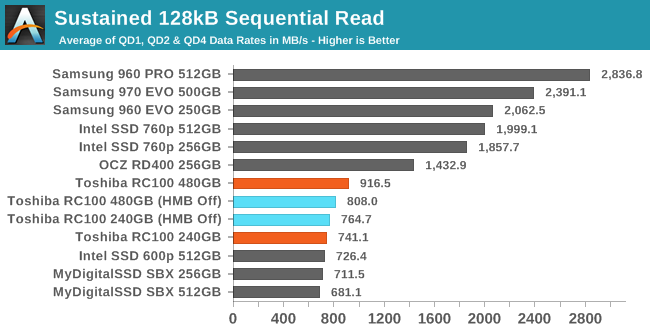
On the longer sequential read test, the RC100 places slightly ahead of other low-end NVMe drives, but there's still a pretty large gap separating it from the high-end drives that can deliver multiple GB/s at low queue depths.
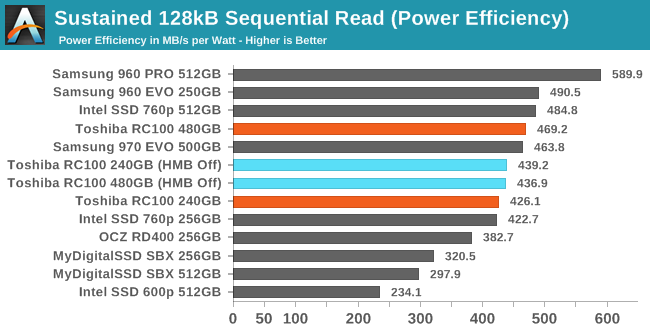 |
|||||||||
| Power Efficiency in MB/s/W | Average Power in W | ||||||||
Power efficiency from the Toshiba RC100 is decent by NVMe standards, but not record setting. Total power draw approaches 2W for the 480GB model, which is still quite low for NVMe drives.
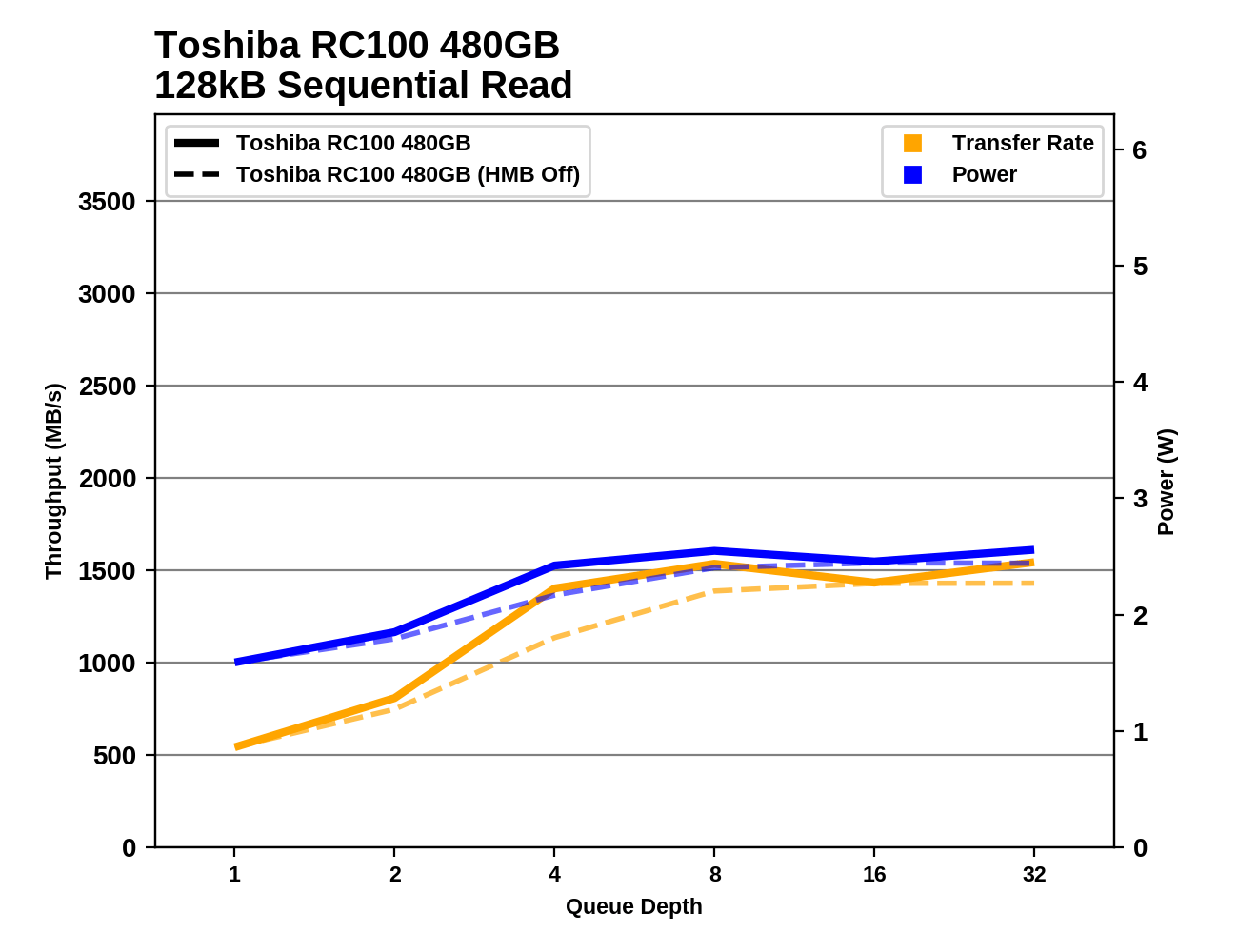 |
|||||||||
HMB appears to have a moderate impact on sequential read performance for the 480GB RC100 at some queue depths. Both capacities hit maximum performance when the queue depth is at least 8.
Sequential Write Performance
Our test of sequential write burst performance is structured identically to the sequential read burst performance test save for the direction of the data transfer. Each burst writes 128MB as 128kB operations issued at QD1, for a total of 1GB of data written to a drive containing 16GB of data.
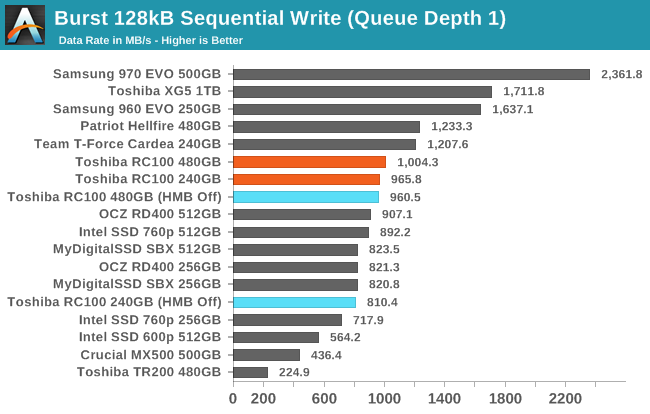
The burst sequential write performance of the Toshiba RC100 is good for a low-end NVMe drive (or an older high-end drive), but is far below the current high-end drives.
Our test of sustained sequential writes is structured identically to our sustained sequential read test, save for the direction of the data transfers. Queue depths range from 1 to 32 and each queue depth is tested for up to one minute or 32GB, followed by up to one minute of idle time for the drive to cool off and perform garbage collection. The test is confined to a 64GB span of the drive.
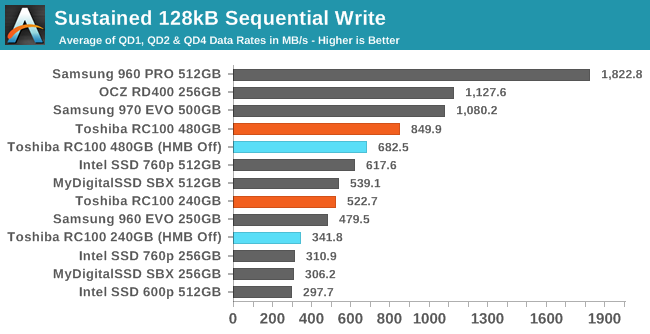
On the longer sequential write test, the RC100 performs quite well with HMB on—it slightly outperforms the 250GB Samsung 960 EVO, but can't keep pace with the newer 970 EVO. Even without HMB, the RC100 is one of the faster low-end NVMe drives for sequential writes, but having that extra buffer helps a lot.
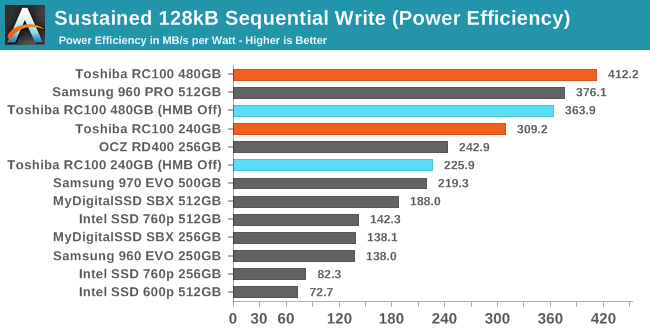 |
|||||||||
| Power Efficiency in MB/s/W | Average Power in W | ||||||||
The Toshiba RC100 finally manages to score a power efficiency win: it just barely cracks 2W during this test and performance is better than most NVMe drives that pull 4W on this test.
 |
|||||||||
he sequential write speed of the 480GB RC100 plateaus at 1GB/s at a queue depth of 2 or higher, but there was a drop in performance at the end of the test that may have been the SLC cache finally running out. The performance from the 240GB takes a bit longer to reach full speed, and without HMB it is both slower and less consistent.










62 Comments
View All Comments
XabanakFanatik - Thursday, June 14, 2018 - link
Seriously? We get this instead of the 970 Pro or 905p review? Did anyone actually care about this drive?Billy Tallis - Thursday, June 14, 2018 - link
Personally, I find doing a review like this to be a lot more interesting than testing an overpriced flagship product where I know going into it that the conclusion will be that a drive 1/2 or 2/3 the price is just as good for realistic use cases. It's interesting to explore the current state of the art for high-end tech, but it's more interesting to explore new tech in the context of something that might also be a sane purchase.XabanakFanatik - Thursday, June 14, 2018 - link
I'm not sure how interest explains why you've reviewed this two days after it shipped but 7 weeks after you posted the 970 Evo review, there is no 970 pro review. Every other inferior review website posted the pro and evo reviews simultaneously, so Samsung must have sent you both drives around the same time.And Seriously, this is more interesting than reviewing the first optane refresh 905p?
close - Thursday, June 14, 2018 - link
They're usually very late with most reviews. Except Intel ones.Ostensibly because they want to provide the best information out there.
Samus - Thursday, June 14, 2018 - link
Need a review of a 970 Pro? Read the 970 Evo review and assume it’s moar better for proportionately moar money.bananaforscale - Monday, July 9, 2018 - link
Not proportionately. Flagship products *never* have a price that's proportional to performance.artifex - Thursday, June 14, 2018 - link
You already know a bazillion other sources for a 970 Evo review, so you're beating this guy up for being different? He says doing this review is more interesting for him, so no wonder he did it.Also, since you're calling Anandtech an inferior review site, he's hardly likely to change just for you, now.
XabanakFanatik - Thursday, June 14, 2018 - link
I was saying every other review site was inferior, yet they posted 970 PRO reviews the same time as 970 EVO reviews. My issue with Anandtech was the sole posting of the 970 EVO review and no 970 PRO review now for over 7 weeks.Nobody tests like Anandtech. I'm sad that the halo drives aren't a priority for Billy, since the market for them is actually really big.
lmcd - Thursday, June 14, 2018 - link
Most people I know look at the 970 EVO as the highest price drive they'll consider. I almost didn't even consider it.XabanakFanatik - Thursday, June 14, 2018 - link
I can think of a half dozen people I know that would have never considered the 900 Pro drive at the previous price point that bought one after Samsung's mysterious price drop at launch of the 970 series. Lopping off 20-25% of MSRP tends to work pretty well to sell a new generation that was previously priced too high.